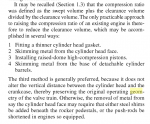PaulRainbow
Well-Known Member
Valvetrain geometry, exhaust and carb manifold issues, engine mounting etc, eg the angles between the valves/rockers/pushrods/cams.
Please accept that given the variety of valvetrain designs, eg chain, belt, desmodromic etc I can't included every variable in every post but, yes, similar issues exist.
Possibly the biggest load of drivel you have typed in this thread, hard to be sure, you have typed so much utter garbage.
how the hell does skimming head change "the angles between the valves/rockers/pushrods/cams." and all of the other nonsense you just typed ?

